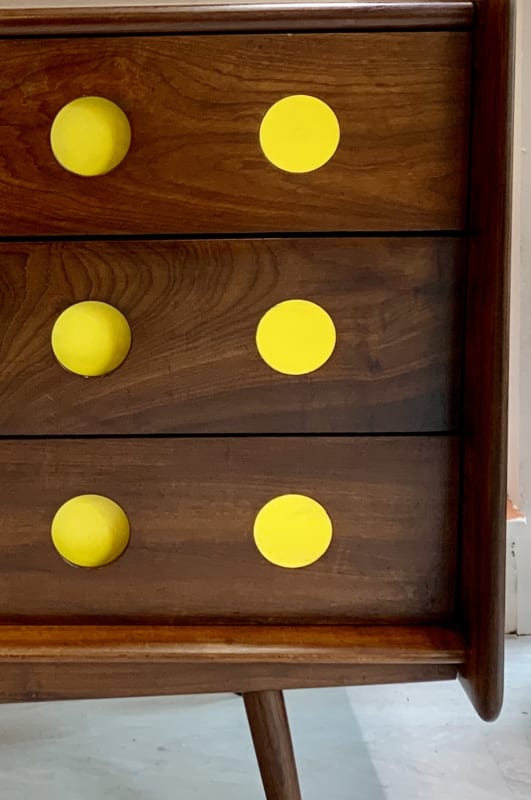Móveis Cimo Brésilien
Founded in 1913 in Santa Catarina, southern Brazil, initially by Jorge Zipperer (1879-1944) and Willy Jung (1879-1919) and "named Jung e Cia", Moveis Cimo was the largest furniture factory in Latin America from the 1930s until the 1970s. In 1919, with the death of Jung, Jorge Zipperer joined forces with his brother Martin Zipperer (1890-1971) who had a solid background in carpentry.
From the beginning, Moveis Cimo had several different corporate names due to the changes in the partners and the growth of the company, the name "Moveis Cimo" was only used from 1954.
Always very attentive to the technological novelties of the time, the products of the workshop have been marked by its modernization and optimization of the raw materials, always keeping the high quality know-how. Moreover, through the edition of their catalogs where the materials and techniques used were shown, the company allowed the diffusion of the knowledge of the modernist style.
Beyond the technical aspect, the modernization has made possible the large-scale production of pieces in series, allowing the company to respond to many institutional orders, including for cinemas, theaters and schools. In addition, Moveis Cimo maintained a catalog for residential furniture, mainly from the 1950s, with the modernization of Brazil and the construction of the new capital, Brasilia, and its demand for furniture more suitable for the new architecture.
The forms created by Moveis Cimo illustrate the passage from the aesthetics of traditional furniture with strong references to Portuguese colonial furniture to modern design. Moveis Cimo's residential furniture carried an innovation in design and material. "In these aerodynamic forms, in the bases of the chairs in conical shape (later known as 'pé palito'), gave lightness to the piece; the use of materials created in the post-war period, such as plastic laminates, known as 'formica', imitated wood and other materials; also intensified the use of metal, courvin in the upholstery usually with very bright colors." (SANTI, 2013, p. 292). This was possible thanks to the attention that the Zipperer brothers paid to technological developments coming mainly from foreign countries through the many trips they made to Europe, the technique of steam lamination of wood was one of those innovations that they took from Hamburg, Germany, and were the first to develop in Brazil.
From the 1960s, with the death of Martin and Jorge Zipperer, the company employed several French and Dutch designers with the intention of changing its aesthetic line by becoming more neoclassical, but ended up losing its identity.
Fondée en 1913 à Santa Catarina, dans le sud du Brésil, initialement par Jorge Zipperer (1879-1944) et Willy Jung (1879-1919) et « nommée Jung e Cia », Moveis Cimo a été la plus grande usine de meubles en Amérique Latine des années 1930 jusqu'aux années 1970. En 1919, avec le décès de Jung, Jorge Zipperer s’associe avec son frère Martin Zipperer (1890-1971) qui avait une formation solide en menuiserie.
Depuis l’origine, Moveis Cimo a eu plusieurs raisons sociales différentes étant donné les changements des associés et la croissance de l’entreprise, le nom « Moveis Cimo » a été employé seulement à partir de 1954.
Toujours très attentifs aux nouveautés technologiques de l’époque, les produits de l’atelier ont été marqués par sa modernisation et l'optimisation des matériaux premiers en gardant toujours le savoir-faire de haute qualité. Par ailleurs, à travers l’édition de leurs catalogues où été montrés les matériaux et les techniques employés, l’entreprise a permis la diffusion de la connaissance du style moderniste.
Aux delà de l’aspect technique, la modernisation a rendu possible la production à grande échelle de pièces en séries, permettant à l’entreprise de répondre à de nombreuses commandes institutionnelles, notamment pour les cinémas, les théâtres et les écoles. À côté de cela, Moveis Cimo maintenait un catalogue pour le mobilier résidentiel, principalement à partir des années 1950, avec la modernisation du Brésil et la construction de la nouvelle capitale, Brasilia, et sa demande pour un mobilier plus adéquat à la nouvelle architecture.
Les formes créées par Moveis Cimo illustrent le passage de l’esthétique du mobilier traditionnel avec de fortes références au mobilier colonial portugais vers un design moderne. Le mobilier résidentiel de Moveis Cimo portait une innovation dans le dessin et dans le matériel. « Dans ces formes aérodynamiques, dans les piètements des chaises en forme conique (plus tard connu comme ‘pé palito’), donnait légèreté à la pièce ; l’utilisation de matériaux créés dans la post-guerre, comme les laminés plastiques, connus comme ‘formica’, imitait le bois et d’autres matériaux ; s’intensifiait aussi l’usage du métal, du courvin dans les tapisseries généralement avec des couleurs très vives. » (SANTI, 2013, p. 292). Cela a été possible grâce à l’attention que les frères Zipperer portaient aux développements technologiques venus principalement des pays étrangers à travers des nombreux voyages qu’ils faisaient en Europe, la technique de laminage à vapeur du bois fut l’une des ces innovations qu’ils ont emportées d’Hambourg, Allemagne, et ont été les premiers à développer au Brésil.
A partir des années 1960, avec le décès de Martin et Jorge Zipperer l’entreprise a employé plusieurs designers français et néerlandais dans l’intention de changer sa ligne esthétique en devenant plus néoclassique, mais a fini pour perdre son identité.




